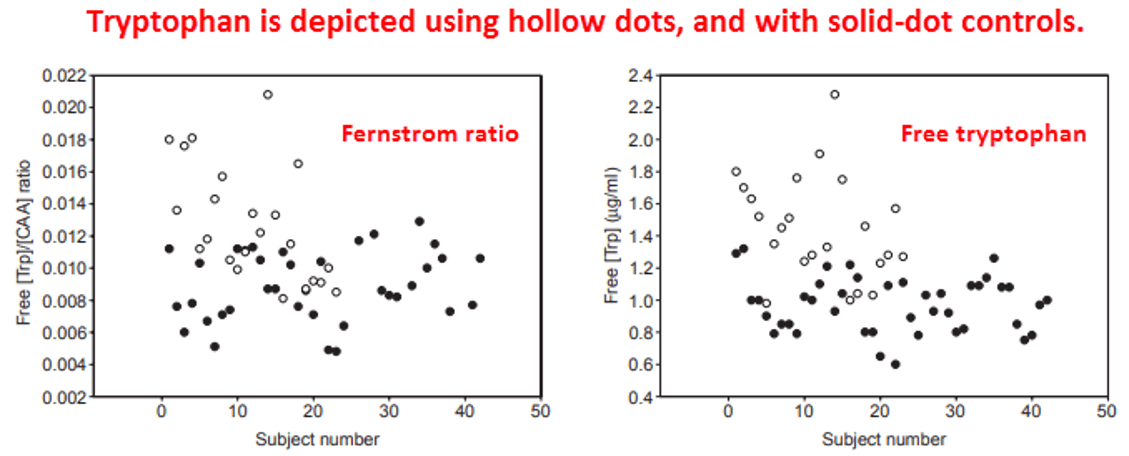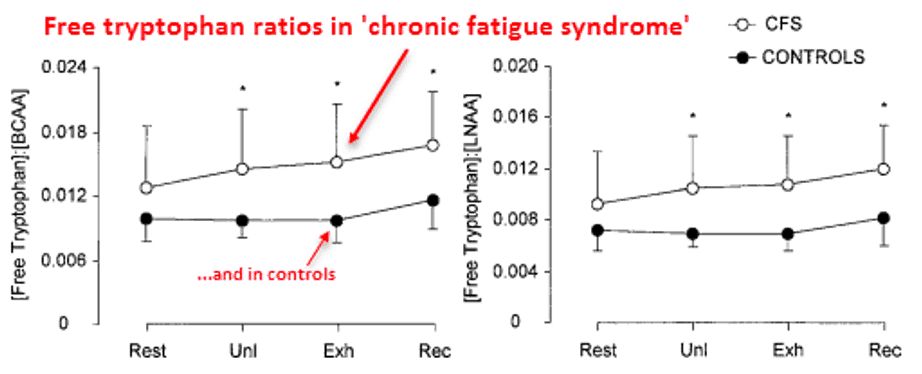
[cmamad id=”15767″ align=”center” tabid=”display-desktop” mobid=”display-desktop” stg=””]
Is this making you tired all the time?
—————–
For the man who is tired and needs naps
Chronic fatigue syndrome (CFS) is a broad category used to describe generally tired people who cannot be classified more precisely.
Very often the condition also involves muscles.
But, since the overly-inclusive “chronic fatigue syndrome” is now an official diagnosis, scientists are using formal epidemiology to investigate connections within and without this broad group of patients.
Dozens of disparate explanations and theories of CFS have followed from this…
Science is trying to biochemically define a group that is not definable when taken as a whole.
Since CFS represents a less-precise diagnosis by current standards (much like autism or Alzheimer’s disease), even the strongest correlations are often somewhat weak.
And this obscures the cause.
But one correlation has always stood out:
Historically, so-called chronic fatigue syndrome has been found in association with high levels of tryptophan (an amino acid famously found in turkey and other poultry) and serotonin levels.
And eosinophils (white blood cells that fight disease) are nearly always increased as well.
This makes most cases of CFS essentially a repackaged eosinophilia-myalgia syndrome.

Due to the overly-inclusive nature of the CFS diagnosis, patients with autoantibodies to acetylcholine receptors or to the thyroid gland are sometimes thrown in.
These two subgroups are then essentially misclassified as having Hashimoto’s or myasthenia gravis, and are a tryptophan-independent subset.
[cmamad id=”15768″ align=”center” tabid=”display-desktop” mobid=”display-desktop” stg=””]
But the strongest data indicates that tryptophan is the primary factor in the majority of cases.
Even for generally tired people who have not been formally diagnosed, the important role of tryptophan in fatigue, in general, could be the key to overcoming that.

In the early 1990s, Mark Demitrack tested monoamines (neurotransmitters) in 19 people who fit the criteria for chronic fatigue syndrome.
This involved more than simply drawing blood.
The researchers did spinal taps on all of the participants. A spinal tap determines cerebrospinal fluid concentrations, which more accurately reflect the brain concentrations.
They tested for three monoamines: the main metabolite of dopamine (HVA), that of adrenaline (MHPG), and that of serotonin (5-HIAA).
In what would later become a consistent finding, levels of plasma and cerebrospinal fluid 5-HIAA were increased:

The levels were especially high in plasma – nearly doubled.
Perhaps what keeps some scientists from investigating the serotonin connection more deeply is the observation that the increases in brain serotonin are relatively modest.
But serotonin is a neurotransmitter that works on serotonin receptors everywhere in the body, even peripherally.
Serotonin receptors exist at the majority of nerve junctions, including those associated directly with muscle.
The researchers also noted slight reductions in adrenaline and dopamine metabolites.
Low adrenaline could only be thought to exacerbate serotonin-induced muscle fatigue.
“Patients with chronic fatigue syndrome demonstrated a significant reduction in mean basal plasma levels of the norepinephrine metabolite, MHPG, and a significant elevation in mean basal plasma levels of the serotonin metabolite, 5-HIAA, when compared with normal individuals.”
And there are many more studies that show this.
There is a mountain of evidence highlighting the consistency and strength of the connection between serotonin and chronic fatigue:

This particular study was done on CFS patients in the UK. When it comes to tryptophan levels, the results were basically the same.
Using the blood of 23 chronically tired people, tryptophan was again found to be the main outlier.
Specifically, free serum tryptophan was higher:

The o (hollow dot) was the Fernstrom ratio, which is the sum of tryptophan over that of its competitors (for brain uptake).
The Fernstrom ratio is the most accurate index for brain serotonin synthesis, something which this investigator perhaps focused on too heavily.
The variety of fatigue seen with tryptophan and serotonin appears to be more peripheral.
“There is evidence that serotonin is the neurotransmitter responsible for causing a state of tiredness and sleep in man and experimental animals.”
This is a stumbling block for those who think brain serotonin is the only serotonin to consider.
And that includes Fernstrom himself who cannot explain tryptophan fatigue.
Fernstrom and others are forced to admit that free tryptophan enters the brain nearly as readily as albumin-bound tryptophan.
Everyone is certain that post-workout fatigue is caused by a serum tryptophan increase, but nobody seems to be able to explain how it works.
Post-workout fatigue is also called central fatigue.
The striking parallels between that and chronic fatigue haven’t gone completely unnoticed:

In this study, subjects previously diagnosed with CFS exercises.
The scientists drew blood from the subjects before exercise and again after exercise.
The subjects diagnosed with CFS had higher initial circulating tryptophan levels than the control subjects.
And these levels were further increased after exercise, though slightly:

It’s easy to see from the graph that the free tryptophan rise after exercise (post-workout fatigue levels) couldn’t even match that of baseline CFS.
So having chronic fatigue can be seen as always being in a post-workout condition.
Tyrosine levels were decreased by 21% at rest (Table I).
This is important because this amino acid is the precursor for catecholamines: adrenaline, noradrenaline, and dopamine.
This is chronic fatigue mimicking adrenal fatigue.
And an enzyme that degrades tryptophan is induced by cortisol, a steroid hormone secreted by the adrenal cortex.
This researcher discussed the low tyrosine and had a more realistic outlook than most scientists who study this issue.
He was open to the idea that tryptophan and/or serotonin could be working peripherally on the nerves and muscles themselves.
“In addition to its pro-inflammatory effects, peripherally secreted serotonin also potentiates the nociceptive effects of painful stimuli in both animals and humans.”
In fact, tryptophan is so known for causing fatigue that post-Thanksgiving fatigue is most commonly explained by the relatively high tryptophan concentrations in turkey.
One might think that supplements – as they have more tryptophan than turkey – would certainly cause more fatigue:

This is actually a very common finding.
However, post-L-tryptophan fatigue is usually classified as eosinophilia-myalgia.
This syndrome was named for the observed myalgia (medical Latin-jive for muscle weakness/pain) and also for the elevated eosinophil levels always associated with this.
“As soon as the treatment [L-tryptophan] was discontinued, new symptoms – namely myalgia, muscle weakness, and malaise – appeared in both subjects.”
Eosinophils are a variety of immune cells that stain with eosin.
They nearly always accompany elevated tryptophan levels.
Eosinophils actually have serotonin receptors (5-HT₂), and these have been shown to migrate – they “roll” end-over-end along blood vessels – towards a serotonin gradient.
Proteins made by eosinophils have been found elevated 2.47× in chronic fatigue…
But in the early ‘90s, eosinophilia-myalgia syndrome was falsely blamed on an impurity in L-tryptophan supplements from just one manufacturer.
That supplement was 3-(phenylamino)alanine – PAA.
This is yet another stumbling block against the realization that CFS is primarily a tryptophan-serotonin excess.
“Their clinical picture [after taking L-tryptophan] was indistinguishable from that of chronic fatigue syndrome as defined by the Center for Disease Control.”
This link was very likely spurned because of the realization that, although “Spanish toxic oil syndrome” was caused by the use of aniline as an adulterant, the amount found in L-tryptophan supplements was much smaller.
Aniline only produces slight changes in spleen weight using milligram per kilogram doses.
Even more embarrassing to that theory is that the L-tryptophan impurity itself is even less toxic than aniline.
“In the current study, 3-(phenylamino)alanine produced no EMS-like conditions when administered by gavage to Sprague-Dawley rats at dosages up to approximately 37,500 times higher than those to which humans were exposed.”
(Sprague-Dawley rats are rats bred for medical research.)
Moreover, the chemical which had caused toxic oil syndrome wasn’t even aniline, but aniline bound to oleic acid.
This is highly similar to oleamide, a very powerful serotonergic agent.
First isolated from the cerebrospinal fluid of sleep-deprived cats, oleamide had later been shown to bind to three separate serotonin receptors: 5-HT₁, 5-HT₂, and 5-HT₇.
Oleamide had been shown to increase the response of serotonin by about500% in nanomolar concentrations…
…making oleamide just as serotonergic as serotonin itself.
Oleamide certainly has unique and specific serotonergic effects nearly identical to the lipid found associated with toxic oil syndrome.
But, since the Spanish toxic oil fiasco happened in the 1980s and oleamide wasn’t discovered until 1994, nobody made the connection.
Instead, the less powerful aniline was blamed.
They were close but still incorrect, so they ended up having to tie everything together with flaky, unrealistic explanations, wrongly packaged.
The evidence indicates that tryptophan and serotonin are the primary candidates for causing most fatigue – chronic or otherwise.
Supporting roles are played by tyrosine, oleic acid, and NH₃.
Tyrosine is the precursor for adrenaline, noradrenaline, and dopamine.
All of these are necessary for counteracting fatigue.
An even more direct precursor for catecholamines is L-DOPA.
There are natural supplements containing L-DOPA…
The plant Mucuna pruriens (velvet bean) makes L-DOPA in relatively high amounts.
And of course oleic acid and ammonia must play a role – these molecules represent the two precursors for the potent, specific, and serotonergic oleamide.
This would make oleic acid the one fatty acid with the most fatigue potential.
And that is just one more thing that makes coconut oil even better than olive oil for cooking and other food uses.
—–Important Message—-
Speed up your metabolism and regain youthful erections – here’s how…
Did you know that as a man ages, his testicles stop producing as much testosterone? His Leydig cells run out of juice.
Your early warning signs: your stamina falling, your metabolism plummeting, your penis flopping (useful for peeing but that’s all.)
Fortunately, you can recapture a lot of your youth by taking advantage of a discovery called “mitochondrial uncoupling.”
#1: Big Pharma is spending over $2 billion a year on this…
#2: Mitochondrial uncoupling drives a man’s T way higher, and pushes cells to a higher youthful energy level…
#3: You can do this at home, safely, with a very simple cheap supplement you may already have…you take this one special supplement…

This one special supplement increases your youthful metabolism and boosts your sexual performance.
————–


Leave a Reply